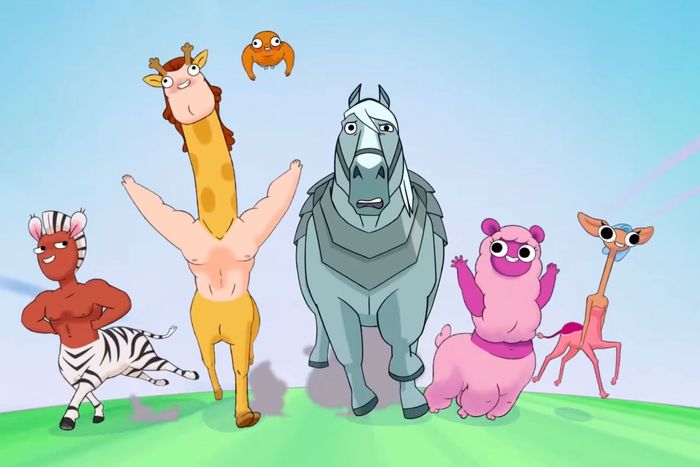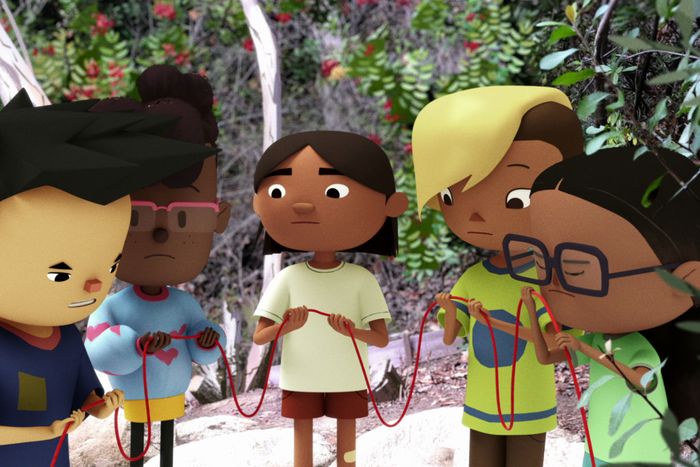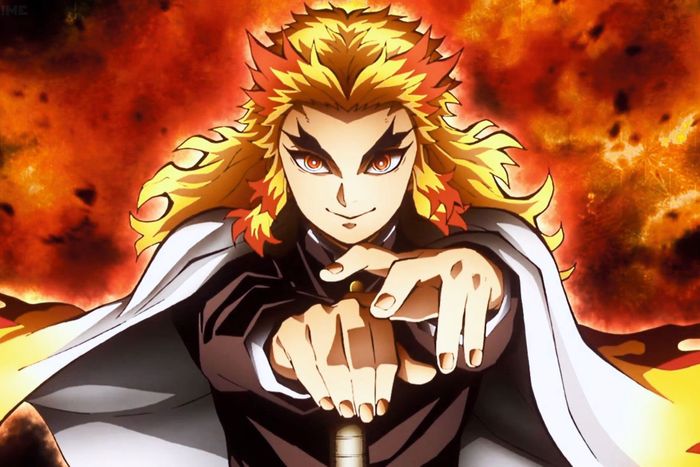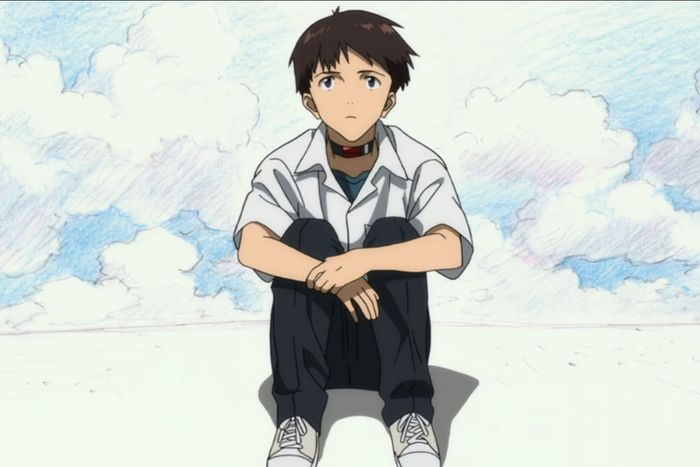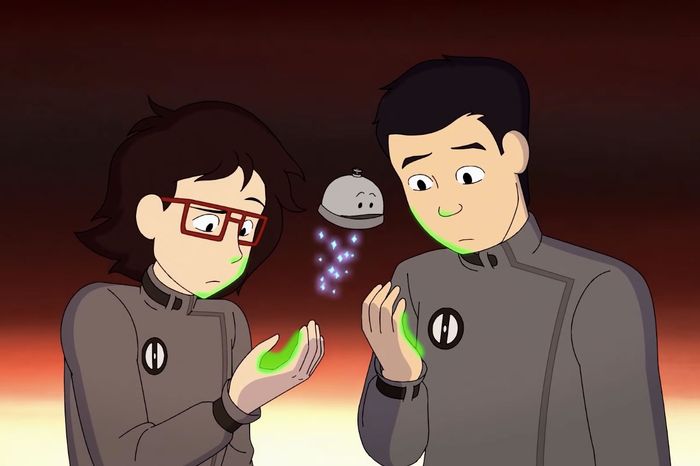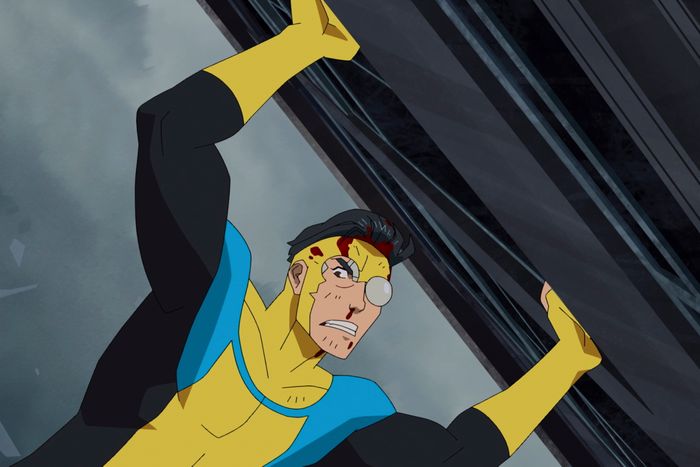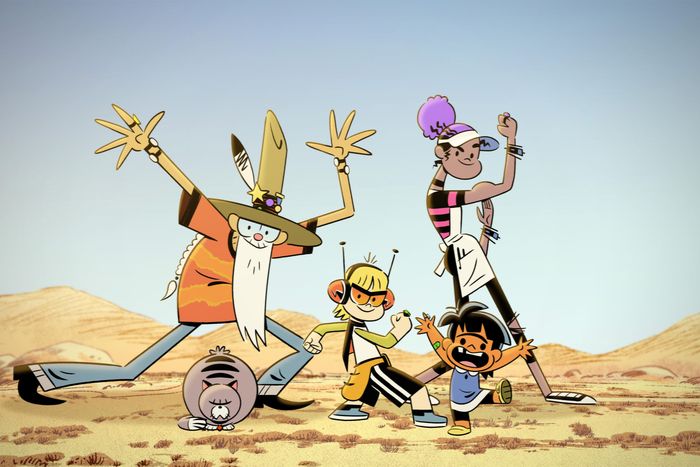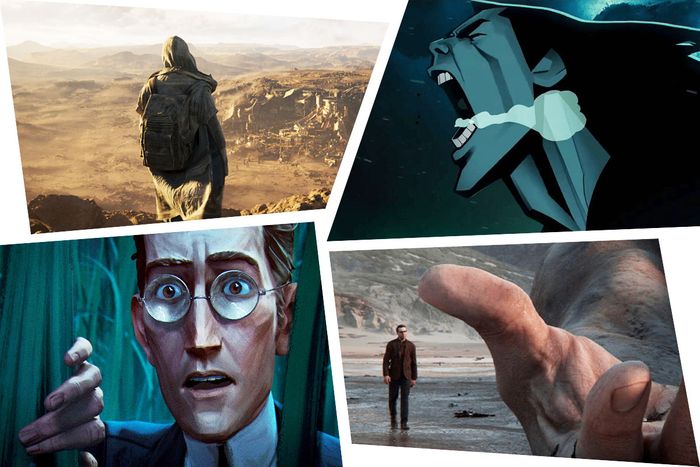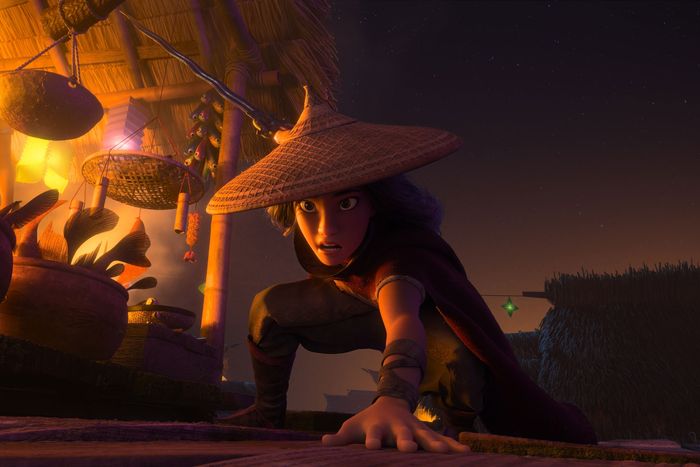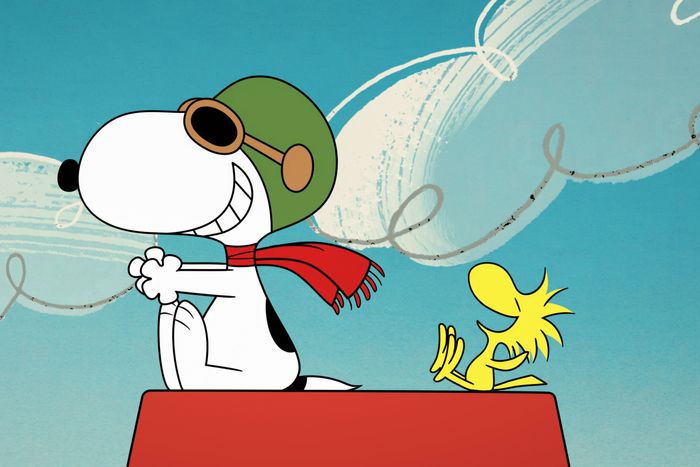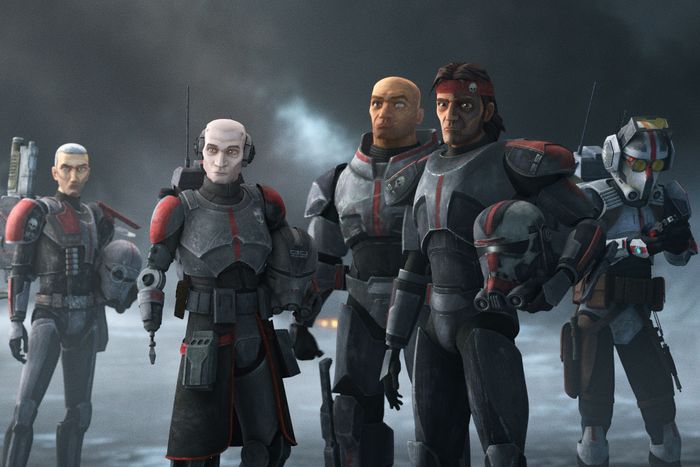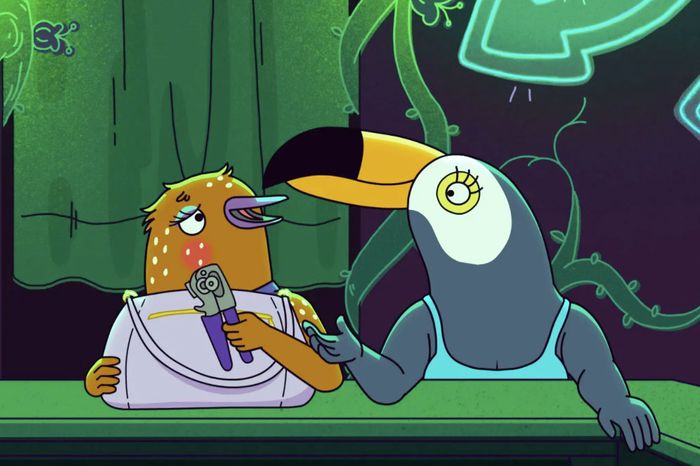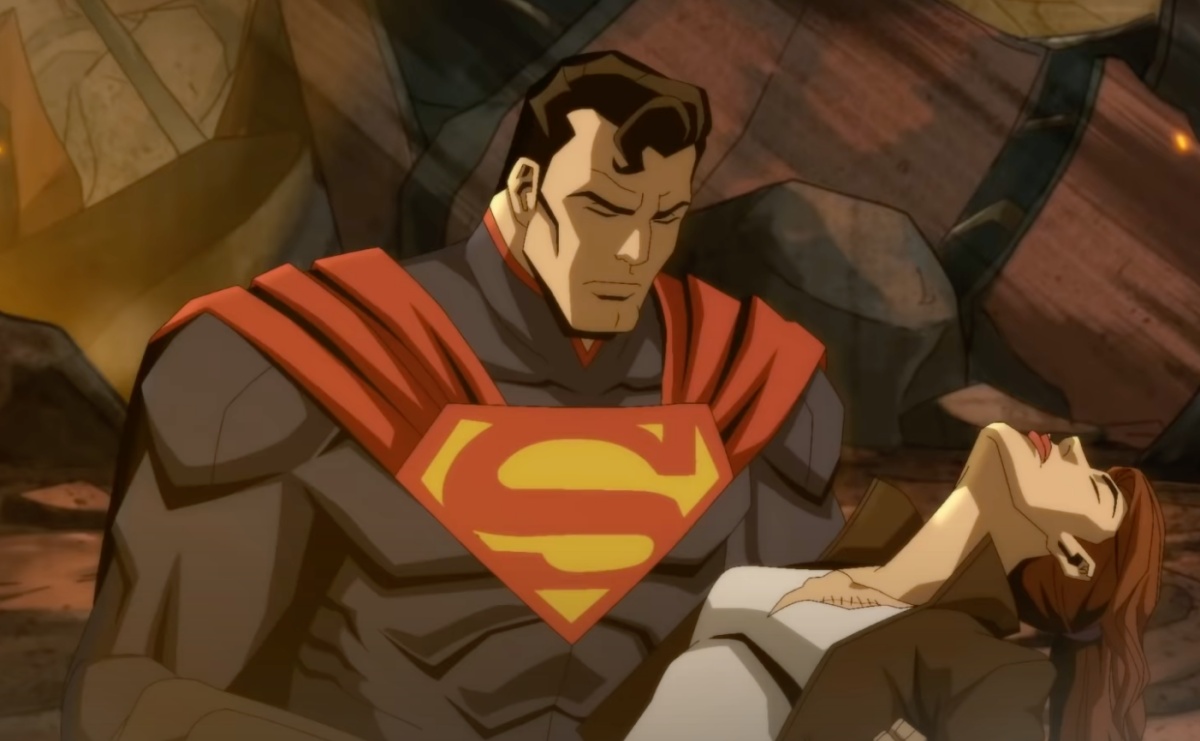The Best Animation of 2021 (So Far)
18 min read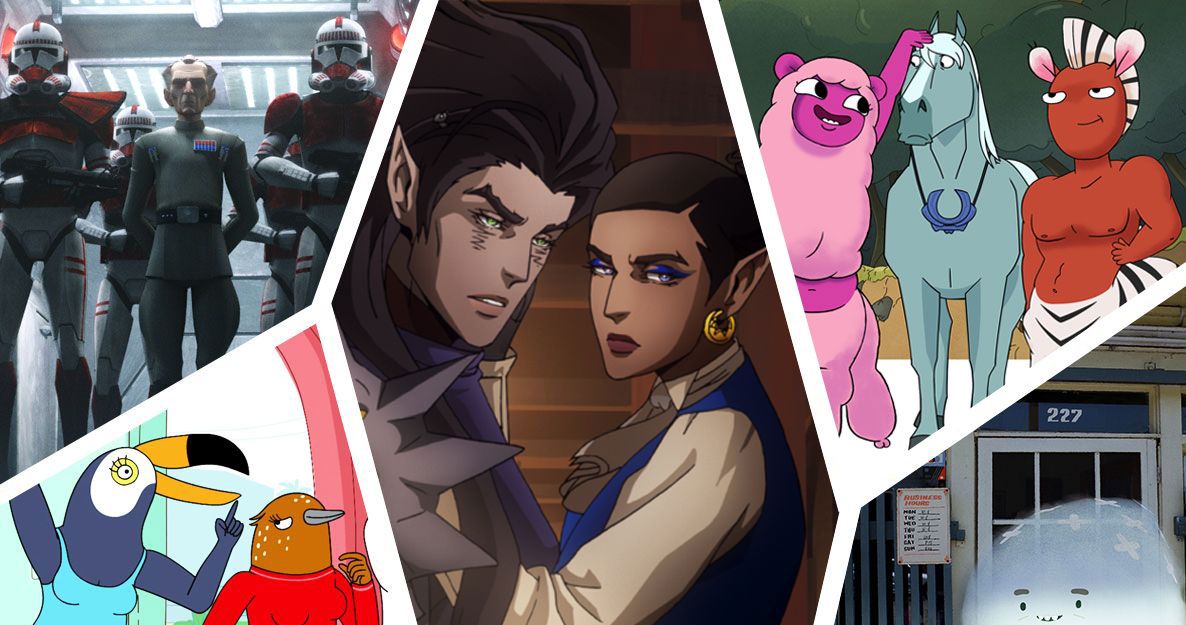
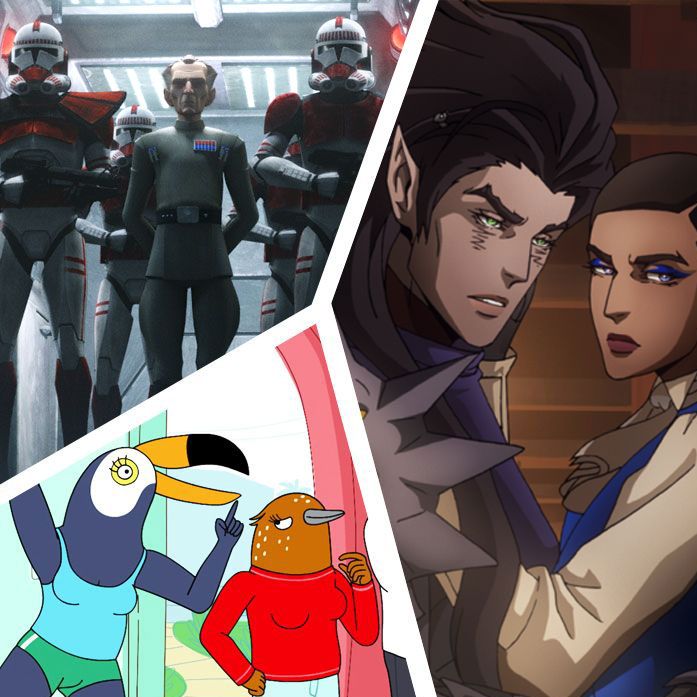
Photo-Illustration: Vulture. Photos: Lucasfilm, Netflix, Disney+, Adult Swim
2021 is shaping up to be a big year for contemporary animation, with streaming services investing heavily in the medium’s future after the pandemic made the value of moving pictures that can be produced from a safe distance even clearer. While most of those recently announced projects are still years away, the first half of 2021 hasn’t been too shabby for cartoons, either — we’ve gotten to witness multiple intriguing twists on classic characters and formulas, beloved series coming to a close, and a thrilling action movie from one of the biggest studios in Hollywood. As we journey through what’s shaping up to be a definitive year in cartoon history, we’ll be here noting the highlights along the way.
New additions since the last update are marked with a ➽.
Canadian Inuit director Zacharias Kunuk’s Inuktitut-language film, rooted in Inuit folklore, is a magnificently eerie stop-motion short with a simple story: A shaman and her apprentice make a house call to a sick man, then visit the underworld to learn why he won’t recover. In its tone and subject matter, the short is reminiscent of Japanese animator Koji Yamamura’s adaptation of Franz Kafka’s A Country Doctor, but in lieu of Yamamura’s exaggerated squash-and-stretch figures, the stop-motion here is subtly cinematic. The visual details are extraordinary — the bright light of sun on snow, the dim glow of a low fire in an igloo, the cold sweat on a sick man’s face, so realistic you can almost smell it through the screen — and the sound design is almost claustrophobic. And while Kunuk’s tale shares A Country Doctor’s fascination with illness, death, and the afterlife, the film’s mythological underpinnings eschew Kafka’s existential alienation in favor of something more spiritually profound, albeit equally perturbing. A gorgeous, unsettling film.
There hasn’t been a more chaotic anime produced in recent memory than Attack on Titan, a show about the conflict between a race of people that can transform into humanoid behemoths capable of inflicting massive destruction — and gobbling up lots of victims while they’re at it. Though it’s always been controversial for its violence and perceived ideological bent, Attack on Titan: The Final Season (which premiered in 2020 but aired most of its episodes so far in 2021) so far feels like an exciting and worthy conclusion to the series. Alliances have radically shifted, and there are new characters who question the evolution of the heroes and villains we’ve followed since the show’s debut in 2013. The result is exceptional, blockbuster serial storytelling from the animation studio MAPPA, which took over from Studio Wit. The series has never been subtle, and criticism of its use of fascist imagery and references to Nazi Germany remains important to serious discussions about its cultural value, but it feels important to state that Attack on Titan has no real winners. Its central commentary is that generational trauma, political maneuvering, and the weaponizing of hate and bigotry leave reverberating, kaiju-size impacts on society. That message has never felt clearer than in this season.
➽ This prep-school anime gone wild — its protagonists are anthropomorphic animals — is arguably one of the best to hit Netflix in the past couple of years (which is really saying something, considering the streaming service’s investments in the anime space) and inarguably one of its weirdest. The world of this series is one in which carnivores have, by and large, given up eating meat to live alongside herbivores, but the urge to slake their thirst for blood is a hard one to overcome. Is a series whose wolf protagonist pines over a white dwarf rabbit upperclasswoman while trying to unravel the mystery of who ate his friend as his school’s star acting student, a deer, drops out to lead a lion pride specializing in black-market meat sales going to be for everyone? Probably not. Still, the show is compelling because of its strangeness, not in spite of it, and the second season’s doubling down on both its murder mystery and soap-operatic elements is as satisfying as a big, red, juicy steak.
Film and television adaptations of video games are, as a rule, a risky enterprise, and one could have been forgiven for writing Castlevania off entirely as soon as it was announced. Dungeon-crawlers in the Metroidvania build are not typically heavy on character building or plotting, two necessities for serial television, and it’s not like there wasn’t already plenty of Dracula or vampire–centric movies and series to watch, even if limited to anime. And yet over the course of its four-season run, the “American anime” that was Castlevania became, against all odds, one of the finer animated series out there. Its characters were not only compelling but surprisingly complex, and its take on Dracula as a broken widower made an overused supernatural villain interesting again. Its story arcs, meandering though they could be, were extraordinary vehicles for the exploration of those characters, be they jaded and maligned monster hunters or vampiress girl bosses whose brand of feminism meant “tak[ing] things away from stupid, evil old men.” And its animation, which only got better by the season, featured some of the most fluid action sequences of any show on television, including a stunningly executed final battle involving a duel to the death with, well, Death. The fourth season saw the long-dead Dracula cast his shadow once more over a world that cannot seem to rid itself of its fascination with him. A metaphor, perhaps? Regardless, it augurs well for whatever spin-off comes next.
Photo: Netflix
All-ages, post-apocalyptic found-family fantasies mixing the earnest with the silly and the surprisingly dark have been all the rage in American animation since Adventure Time burst onto the scene in 2010. Centaurworld follows Netflix siblings Kipo and the Age of Wonderbeasts and She-Ra and the Princesses of Power in that tradition and, at first glance, it threatens to be more of the same. It is decidedly not. The show employs two very different animation styles — one somewhere halfway between She-Ra and The Legend of Korra, the other around the middle mark between Adventure Time and Cow and Chicken — while taking the musical theater leanings of Steven Universe and galloping off with them. The series somehow both serves as the natural endpoint of the past ten years of American animation trends and deliberately sends them up one by one, and it manages more than two tear-jerking showstoppers over its ten-episode first-season run. Also, Tony Hale voices Josh Radnor’s giraffe-centaur’s seemingly sentient flatulence, if that’s your thing.
Photo: COURTESY OF NETFLIX
Elizabeth Ito, the creator of City of Ghosts, seems acutely aware of the power that art can hold in a society divided by hate: “Even as we were making it, there was this sense of, We really need this show. Whatever we can make to help us recover,” she told Vulture in an interview about the Netflix show, which feels like a series of dainty skips through L.A.’s diverse and historic neighborhoods and communities. The ghosts in the show represent the living memories and oral histories locked in decades of urban change, and its protagonist Zelda (August Nuñez) acts as a kind of documentarian, cataloguing and explaining that change to viewers. City of Ghosts is an all-ages show, one that at times feels like halfway between Dora the Explorer and Planet Earth. The show’s animation and characters may seem simple, but its stories and background art style is strikingly complex; both reflect the realities of one of America’s richest cultural melting pots.
This oil-paint-on-glass animated feature film has more in common thematically with the gut-wrenching animated war films Funan, Grave of the Fireflies, and Persepolis than the works of paint-on-glass master Alexander Petrov or even 2017’s oil-painted animated feature Loving Vincent with which it shares its visual DNA. It’s a devastating and timely portrayal of child refugees escaping pogroms in an unspecified Eastern European nation, and as the film winds on, the list of their lives’ horrifying turns grows: parental separation, homelessness, human trafficking, the ravages of nature, prison, and seemingly endless loss. The film’s use of bold primary and secondary colors — the bright yellows and reds of protagonist Kyona’s sweater and skirt, the cobalt tattoos on the faces of witches, the greens and purples of circus tents — in strong brush strokes stands out against the drab, watered-down backgrounds of beiges and browns and blacks of the war-torn countryside. The Crossing — co-produced by studios from two of Europe’s historical animation powerhouses, France and the Czech Republic, with a third from Germany — is still on the festival circuit, and not yet available in the States. When it is, it’s worth watching, another powerful war film in a medium not as known for them as it should be.
Photo: Aniplex America
In the first 15 minutes of Demon Slayer: Kimetsu no Yaiba the Movie: Mugen Train, you will lay eyes on a stunningly beautiful verdant forest and Japanese-style cemetery, charming and colorfully designed lead characters, and a fiery demon carved to pieces by a hyper-detailed magic sword before it explodes in a flash of guts and lava. Like the Demon Slayer: Kimetsu no Yaiba series it’s based off of, the Demon Slayer movie is as concerned with heart-stopping action as it is with emotive character work and drama, which might explain how it became the top-grossing R-rated movie of all time. Yes, you might be best off watching the show before starting the film, but our advice is to approach that as an opportunity rather than as a chore.
Photo: Amazon Prime Video
➽ The final installment of director Hideaki Anno’s Rebuild tetralogy of films revisiting his iconic series Neon Genesis Evangelion is a masterpiece, full stop. That it took years upon years to get it finished and released wound up actually being to the film’s benefit on a cosmically meta level. Over and over again, especially in the film’s last act, the director both literally and metaphorically closes the doors on his long-suffering family of psychologically damaged pilots of giant humanoid robots — breaking the fourth wall as he goes on to express what we can only interpret as being his own sense of closure to the series. As the end of a nearly three-decade maxi-series, Thrice Upon a Time all but demands viewers to have at least seen the first three Rebuild films (streaming on Prime Video), if not also the TV series and its theatrical films End of Evangelion and Death (True)² (on Netflix). We’d also recommend the documentary Hideaki Anno: The Final Challenge of Evangelion, to get a fuller sense of the director’s work ethic. But the payoff is worth it.
This donghua, about the adventures of a crown prince turned banished god from ancient China and a powerful ghost feared by nearly all other occupants of the heavenly realm, is remarkable for many reasons. The greatest of those is that it is a queer romance from China, a country where LGBTQ rights are consistently under threat and censorship of the arts is fairly common. That in itself would make it worth the watch, especially considering that the series eschews the queer-baiting so familiar to many anime, but Heaven Official’s Blessing has a lot more going for it than just its (beautiful) central romance. It balances action and intrigue with humor effortlessly. It has a robust mythological backstory rooted in Chinese mythology and philosophy that the first season only begins to tease out, which is a rarity in animation that makes it to American audiences. And the animation itself is gorgeous, incorporating the aesthetics of traditional Chinese landscape paintings into an art style that will otherwise be quite familiar to anime viewers Stateside.
Photo: HBO Max
You can’t say the writers of Infinity Train were averse to trying new things. With each of its seasons, the animated sci-fi thriller anthology series by Owen Dennis tested the limits of its concept, only to find that the concept was nearly as infinite as its metaphorical engine. The series itself, unfortunately, wasn’t so endless — two seasons after its move from Cartoon Network to HBO Max, someone at WarnerMedia killed the show after deciding that it no longer had “a child entry point.” That seems like corporatese for “it’s not making us money,” but the series had indeed grown more adult and darker by the season. And its fourth season — a commentary on co-dependent relationships that saw the fates of its two protagonists tied together inextricably — is, despite the absence of a heel turn leading to a horrifying death scene, just as dark as its third. While the season’s story arc wasn’t quite as tightly woven as in prior seasons, that seemed to be in part the point: as soon as another person’s life, and struggles, are as important to yours as your own in an unhealthy way, the track to acceptance and self-actualization becomes all the harder to stay on. Is that easy for kids to learn? No. It’s not easy for any of us to learn! Is it a powerful and necessary lesson? Yes. And Infinity Train was powerful and necessary television.
Photo: Amazon Prime Video
Amazon Prime’s animated companion to The Boys engages with ideas familiar to most modern adult superhero fare — power versus responsibility, masculinity run amok, the Übermensch, and on and on — but its execution is where it shines. In the first episode, teenager Mark Grayson learns he has superpowers and is a descendant of an alien race; what he doesn’t know is that his father, Earth’s greatest hero, is a murderous psychopath. Produced by Skybound Entertainment, Invincible is staffed by a flock of superhero animation veterans: character models by Invincible co-creator Cory Walker, storyboards by the likes of the Copeland Brothers (Young Justice, Kipo and the Age of Wonderbeasts) and Joaquim Dos Santos (The Legend of Korra, Justice League Unlimited), and supervising direction by Jeff Allen (Ultimate Spider-Man, Avengers Assemble, Harley Quinn). Special shout-outs in particular go to the voice casting, direction, and especially the acting. Steven Yeun leads the cast with an anchoring, relatable performance as Mark, while J.K. Simmons flawlessly juggles a nuanced dual role of father figure and fascist liquidator.
Photo: Courtesy of Netflix
Any new series by Craig McCracken, one of American animation’s great design talents and the creator of The Powerpuff Girls and Foster’s Home for Imaginary Friends, is a bona fide event in the animation world. But Kid Cosmic ups the ante: As McCracken’s first show for a streaming era, it is also his first serialized series. Kid Cosmic may return to the child superhero trope, but the show is anything but a Powerpuff-style episodic beat-em-up showcase. Patient character development, subtle world-building flourishes, and a willingness to explore just how hard it is to grow up — even with superpowers — makes the series an early standout among 2021’s animation slate.
Photo-Illustration: Vulture; Photos by Netflix
While the first season of Tim Miller’s anthology Love, Death & Robots could often feel shambling and emptily provocative, we’re fortunate that there was enough behind its premise to warrant a second run of shorts. Overall the new set of eight episodes (down from 18) feels more focused, better animated, and far richer in its rewards. Several of its sci-fi shorts stand out for their bleak humor — like “Automated Customer Service,” a much darker riff on Wall-E based on a John Scalzi story — as well as their action and suspense — Robert Valley’s “Ice” races against time on a dark, frozen tundra. Wisely, the producers left ample room in the runtime for existential rumination; Miller’s own short “The Drowned Giant” closes out the anthology with a J.G. Ballard story about an inscrutable dead colossus who suddenly washes up on a shore, and how humans react to it.
Gundam’s latest film is the franchise’s best in at least two decades, even if it’s not exactly intended for newcomers. Mobile Suit Gundam Hathaway is functionally a sequel to Char’s Counterattack, the film that closed the book on the conflicts of the original Mobile Suit Gundam series. Like that film, Hathaway is crisply animated and moves at a brisk, politically motivated pace. Its first half’s gunplay and intrigue feel more like watching a James Bond film than a Gundam one (“My name’s Noa, Hathaway Noa,” is how the protagonist introduces himself), and as the first of a planned trilogy, much of it serves as table-setting for a larger conflict. Nonetheless, the film’s major battles excel at dramatizing the dread of watching giant-size robots from the ground, and its warring, mechanized soldiers fly and lumber across the screen with a weight and realism that matches the franchise’s best entries.
➽ A noirish mystery that trades sepia tones for pastels, the cynical cop for a cynical taxi driver, and people for anthropomorphic animals — the cabbie is a walrus! — Odd Taxi is as odd as its name. But it’s also utterly captivating: Its dialogue is as quick as anything Dashiell Hammett penned, its skewering of viral internet fame and other defining characteristics of contemporary culture is consistently on point, and it balances episodic humor with menacing serial storytelling so effortlessly it makes you wonder when Netflix will try to buy up its rights, dub it, and spin it as the next BoJack Horseman. (Protagonist Odakawa is, after all, a suffering middle-age has-been too, although he’s much more likable than BoJack.) Director Baku Kinoshita and writer Kazuya Konomoto employ a quirky visual style and nearly picaresque, dialogue-focused storytelling style that defies many anime expectations and gives the series the makings of a real crossover hit.
Photo: Disney+
Raya and the Last Dragon, one of Disney Animation’s best films in years, works as both a lighthearted kid movie and a martial-arts epic. Delightfully interesting minor players like Tuk Tuk (a cross between a giant insect and an armadillo, played by Alan Tudyk) and Sisu (Awkwafina, playing the title’s dragon) support the young heroine, Raya (Kelly Marie Tran). Raya looks a lot like Korra from The Legend of Korra and acts like Hayao Miyazaki’s Nausicaa — spunky, capable, and committed to saving a world ravaged by man — but has a passion and sword-fighting savvy that’s all her own. Raya’s fight scenes are the film’s jewels, and they’re wondrous to behold thanks to the dynamic animation, landscape backgrounds that reach for miles, and an art style that owes a lot to Southeast Asian culture.
➽ Disney dropped Short Circuit in 2020 to show off its “experimental” short-film slate, and its second season is, somewhat appropriately, too short, with only five films compared to the first season’s 14. Of them, three are marvelous: Going Home, a quietly moving emotional standout about life’s cycles and seasons; Dinosaur Barbarian, which is just begging to go to series as Primal for kids; and Songs to Sing in the Dark, a film so visually stunning it will leave you wondering why Disney hasn’t yet tapped director Riannon Delanoy to make a feature film in its style. It’s more of a compilation than a series, and it won’t take viewers more than a half-hour to watch it in full, but it’s worth that time and then some.
Photo: Apple TV+
“This commercial dog,” Charlie Brown once said of his dog Snoopy, “is not going to ruin my Christmas.” The Snoopy of The Snoopy Show, though, is not the Snoopy of A Charlie Brown Christmas, but instead a vehicle for flights of creative fancy and joyful exploration of the realm of the possible — which, in cartoons, extends nicely into the realm of the impossible. In an era of endless, and endlessly cynical, reboots, reinterpretations, and repurposing, it’s nice to see The Snoopy Show take the approach of being just plain fun for the sake of it. The series manages to honor the specials of Peanuts past while modernizing the tone of the show just enough to keep things interesting.
➽ “Is this a utopia? Or a hell?” One of the leads of Sonny Boy ponders the duality of her situation in the first episode, which quickly establishes the series premise: 36 students and their school building have been transported to another world, where they are slowly developing superpowers. Sonny Boy is an original production from Madhouse director Shingo Natsume, known for working on acclaimed shows like One Punch Man, Fullmetal Alchemist: Brotherhood, The Tatami Galaxy, and Space Dandy. This new show sprints along with Lost-like mystery boxes in hand, racing through intimate character stories in flashbacks as the students attempt to reason with and confront their situation in the present. The worlds they inhabit are stacked with entry and exit points they can navigate by using their powers, and each has rules that slowly reveal themselves. The show can get trippy, with kaleidoscopic animation by Madhouse showcasing the physics-defying realities — and externalizing the social tensions — that the students must face.
Photo: Lucasfilm
➽ Original fans of Star Wars: The Clone Wars will recognize the setup and the tone of The Bad Batch, a blend of PG-level action adventures in the Star Wars universe that were hitherto unexplored in the series’s current canon. Whether The Bad Batch really needed to exist was never as important as the foregone conclusion that it would exist to slake Disney+’s unquenchable thirst for bankable IP. So it really is to the credit of creator Dave Filoni, head writer Jennifer Corbett, lead voice actor Dee Bradley Baker — who continues to ably voice every clone trooper in a main cast of primarily clone troopers — and the rest of its cast and crew that The Bad Batch slaps. The show presents its titular team of rogue troopers, who are thrown into the thick of fighting a totalitarian coup d’état with moral dilemma after moral dilemma, and forced to live with their reactions to it. Like The Clone Wars, its drama works for adults as well as kids — and its keenly staged action animation doesn’t hurt, either.
Netflix’s The Witcher is getting an anime spinoff film, but if you don’t want to wait for something in the same vein, you don’t have to: Trese is right there. As rooted in Filipino folklore as The Witcher is in the folklore of Eastern European, Trese splices the monster-of-the-week adventure DNA it shares with The Witcher with the genetic makeup of police procedurals and adds a flashback element to boot. The manner in which it blends these elements and the techniques of serial and episodic storytelling is almost reminiscent of the earliest, and best, seasons of Arrow, back when it was still breaking new ground for superhero TV adaptations. The series is set in contemporary Manila and follows Alexandra Trese, the city’s lakan babaylan, as she attempts to keep the tentative peace between humanity and the supernatural world in a city beset by worldly problems that are just as difficult to solve as those that involve shape-shifting demons. The show depicts a folklore and culture rarely depicted in global media, let alone with nuance. The first season is far too short, clocking in at only six episodes, but that just means there’s more to look forward to.
Photo: Adult Swim
Adult Swim saving this show from cancellation has already paid off in the episodes screened by critics. Tuca & Bertie more than re-earns its welcome in just a few entries this season, showcasing Tiffany Haddish and Ali Wong’s irreplaceable performances in episodes tackling anxiety, a bachelor/bachelorette weekend, harassment at work, and more. In every episode, the virtuosically stylized animation by the Tornante Company shifts to expose and highlight the pressures and internal tensions afflicting the characters through shifting color palettes, background jokes, and eye-popping movement — demonstrating, just as the first season did, how the medium can be used to represent characters’ interiority.
This slice-of-life series might pack the most laughs per minute of any series available on traditional television or streaming right now. The show’s episodes are short affairs, hovering between 15 and 20 minutes, and are themselves anthologies comprising a handful of much-shorter vignettes, each of which is centered on a gag related to the show’s consistently hilarious central question: What would happen if a terrifying yakuza gave up the life of crime to become an utterly doting househusband? The answer is simple: It would be kinda scary, kinda funny, and ultimately totally adorable. The animation here is fairly rudimentary (although the illustration packs plenty of detail), but that’s almost beside the point; it feels almost more like a moving comic than an animated show, a technique that seems to draw attention to the material from which it was adapted, Kousuke Oono’s eponymous manga. And the voice acting is pitch perfect. Even those who don’t typically gravitate toward anime will find plenty to giggle at here. You can crush this show’s first season in a little over an hour, and you may well be tempted to, but don’t. It’s worth spreading out the laughs.
If you subscribe to a service through our links, Vulture may earn an affiliate commission.
See All

